The Village of Ratho
A history of the village of Ratho in Oxford County.
By Liz Dommasch, Archivist
A rural community, located in the municipality of Blandford-Blenheim in the geographical area once pertaining to Blandford Township, the Village of Ratho was officially established in the early 1850s with the opening of a post office. According to The Place and Stream Names of Oxford County, Ontario written by W.J. Wintemberg in 1925, the village, located on the 12th Concession, was named by Mrs. Barwick who named it after the village of Ratho, Scotland; her childhood home. It is said that Mrs. Barwick, the widow of Major Hugh Barwick, also named the village of Innerkip.
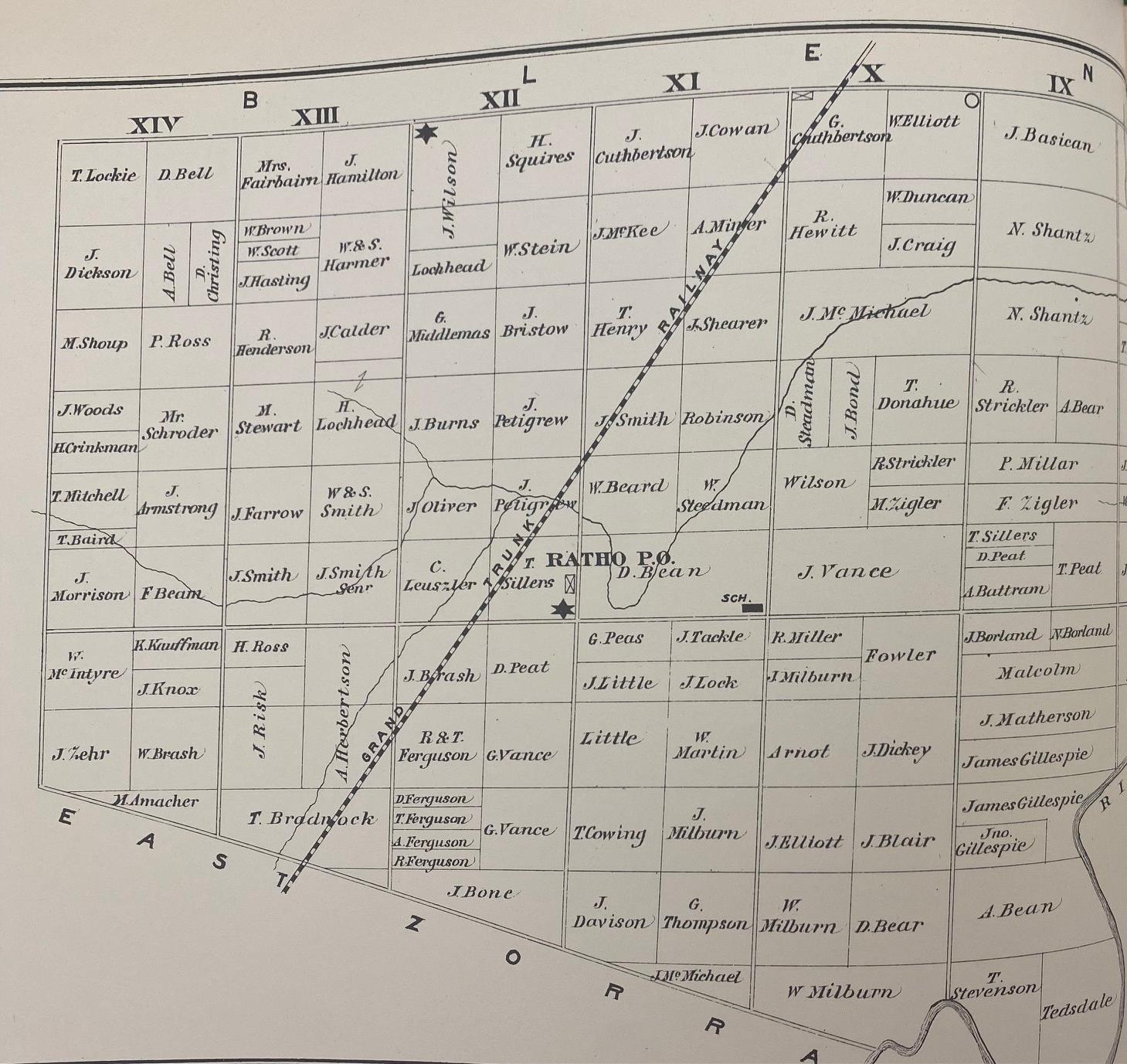
Ratho location in an 1876 Historical Atlas of Oxford County
Many villagers had high hopes that the village would grow with the coming of the Buffalo and Lake Huron railroad in 1857, and one Mr. Morrow was said to have built a large two-storey brick store south of the railway (the beginning of what became known as Upper Ratho) and was instrumental in having lots and streets planned and named in preparation of the town’s development. By 1861, the village had a population of about one hundred and contained two blacksmith shops, a shoe shop, a tailor shop, and the Ratho Hotel, operated by W. Hughes. The village also had a Temperance Order, Ratho Reclaim Lodge I.O. of G.T., which met every Tuesday evening at the Temperance Hall. Over the years, this building had been occupied by a number of organizations including the Ratho Reclaim and the “Patrons of Industry”, before becoming the Independent Order of Forester’s Hall. By the 1950s the building was used as a store, dance hall, wedding venue, and polling station, before being destroyed by a fire in the 1980s.
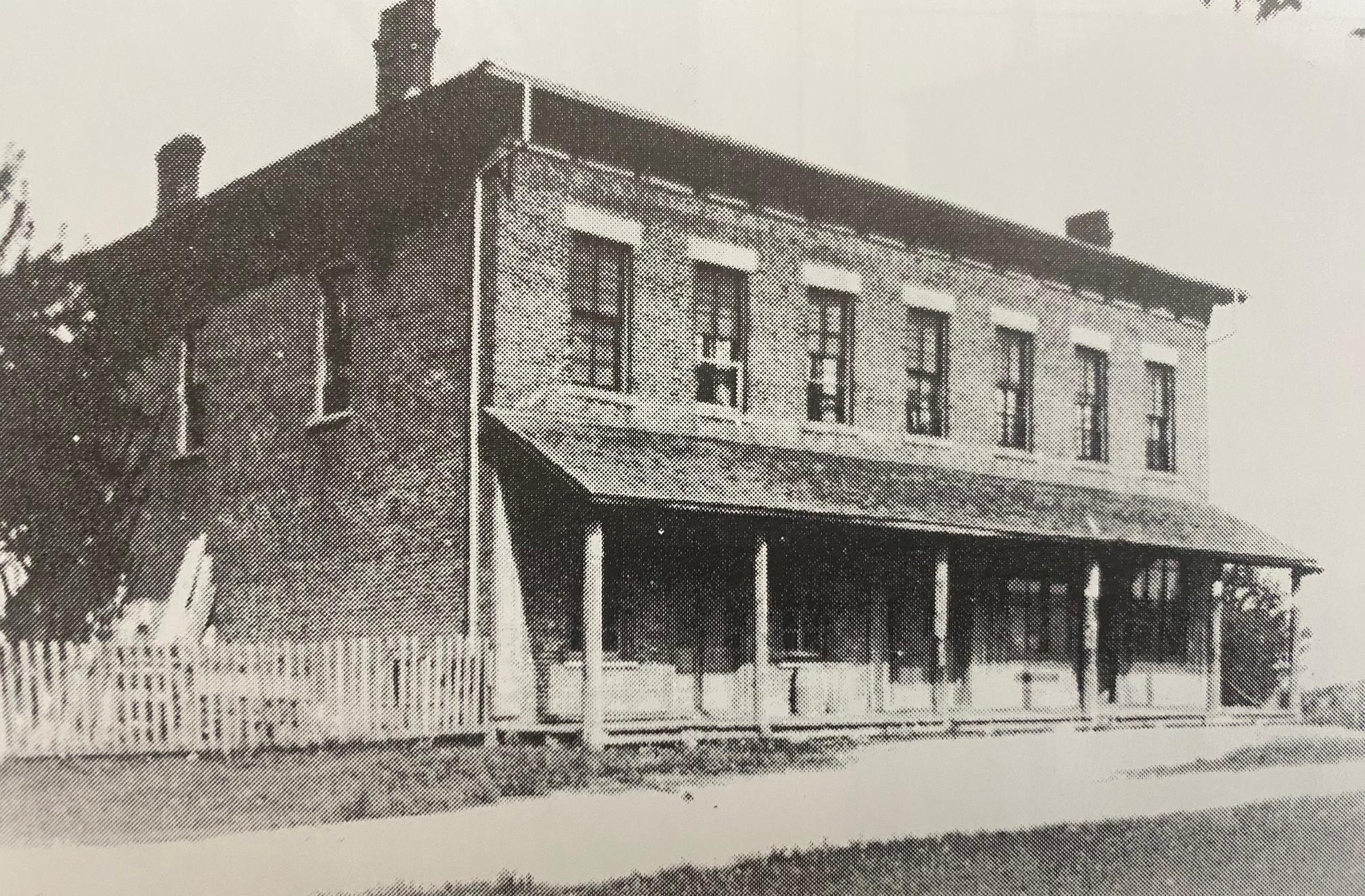
Original Store built about 1857 by Mr. Morrow. "150 Years: 1852-2002, Ratho Presbyterian Church and Community", pg. 71.
By 1881, the population of the village had slowly grown to one hundred and twenty-five, though by the turn of the century, it had dropped to around one hundred again. By WWI, a powdered milk company, Canadian Milk Products, from Hickson (begun initially in Brownsville) opened a branch in Upper Ratho to serve the larger American Market. However, after the war, the plant shut down, due to a lack of demand. This plant was later changed into a fertilizer plant and was run by Art Malcolm.
Religion was quite important to the community, with the first move toward the building of a church being made at a meeting held at the home of Thomas Sillers, in 1851. Mr. Sillers offered a suitable site, free of charge, for a church, and the Ratho Presbyterian Church was subsequently built in 1852 (in the area that became known as Lower Ratho) at the cost of eight hundred dollars. The cemetery would have been built soon after. In 1891, the Ratho Women’s Missionary Society (W.M.S.) was established and remained active for seventy-four years. In 1949, the first meeting of the Goforth Sisters, a junior auxiliary group of the W.M.S. was held. Likewise, in 1925, the first Mission Band was formed under the auspices of the W.M.S. It was later referred to as the Sunbeam Mission Band. The church still plays an active role in the community today.
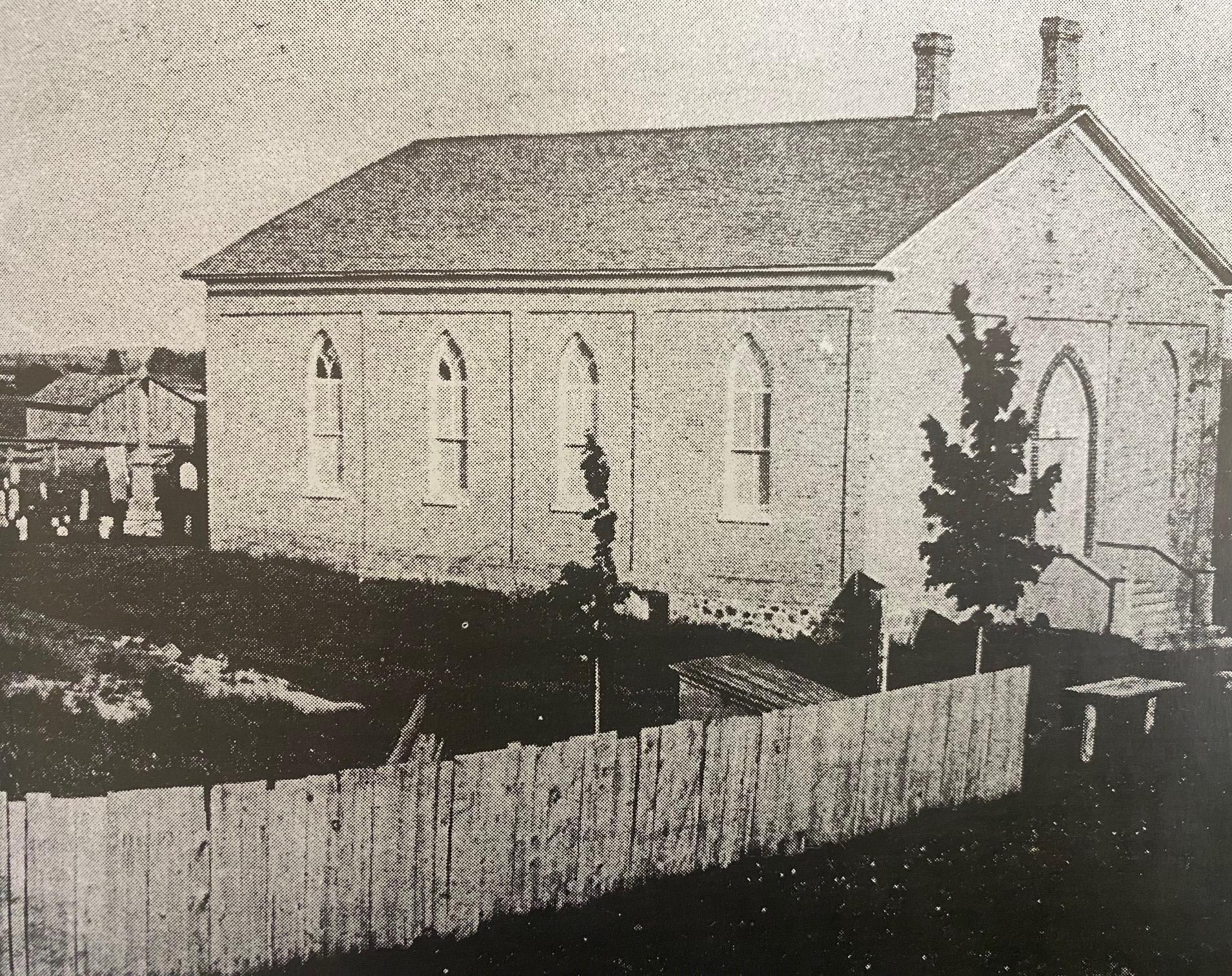
Ratho Presbyterian Church, ca. 1877-1886. "150 Years: 1852-2002, Ratho Presbyterian Church and Community", pg. v.
In 1857, Abraham Bean was paid £12, S10 for a school site, on land located in the south part of Lot 6, Concession 11 of Blandford Township. A two-room school was built about two hundred yards east of the crossroad and later, a frame teacher’s house was built on the southeast corner of the lot. In 1915, a new school was built on the side road south of the corner. In terms of local school fairs, S.S. #4 Blandford was the first school in the township to win not only the Township Championship in Stock-Judging but also the County Championship at the Woodstock Fair. By 1969, the school had closed its doors, and students were bused to the nearby new larger school in Hickson, Ontario.
Today, there is no businesses or industry in Ratho, though it is a pleasant rural community with a rich and vibrant history.
The Freedom Seekers: a new life in Ingersoll
By guest contributor: Vicki Brenner, Digital Literacy & Local History Technician, Oxford County Library
Harvey Cornelius Jackson (1827- 1897) was an African American, born in United States. According to the 1880 USA census, Jackson declares that his parents were born in Kentucky. In 1852, Harvey married Sarah Ann Gibbs in Champaign County, Ohio. The pair likely travelled to Ontario via ferry over Lake Erie from Sandusky, Ohio, perhaps seeking to flee persecution in America. Passed on September 18, 1850 by US Congress, The Fugitive Slave Act of 1850 was part of the Compromise of 1850. The act required that slaves be returned to their owners, even if they were in a free state, such as Ohio. The Jacksons were known to be living in the Port Burwell area and their first child was born in 1856. The couple went on to have a family of eight children, all born in Ontario.
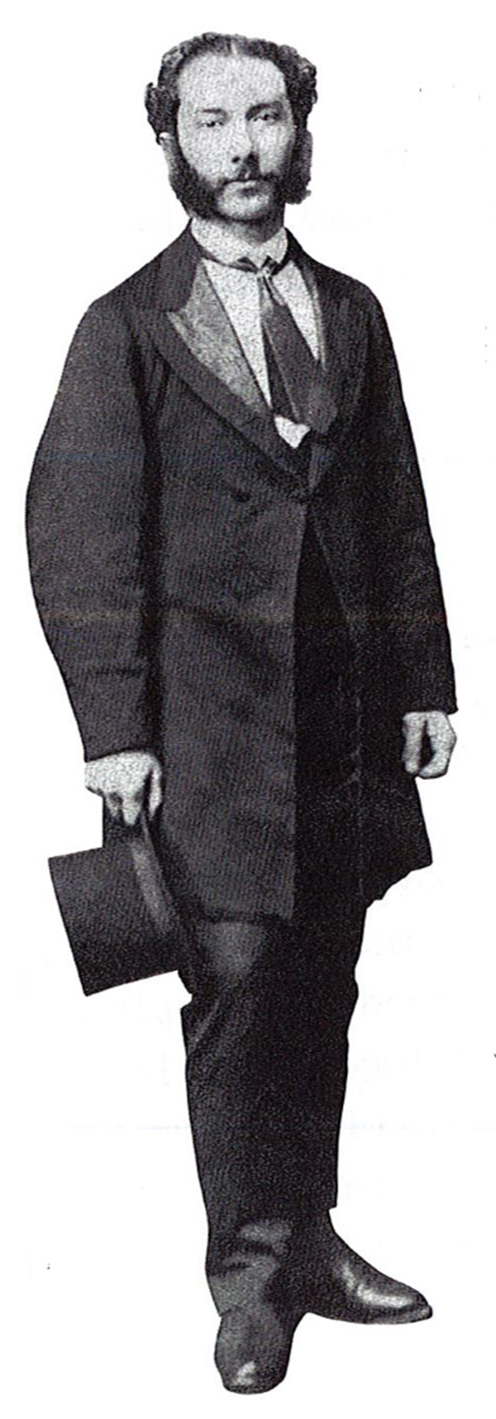
Harvey Cornelius Jackson
Harvey Jackson supported the abolitionist cause and became involved by driving a stagecoach from Port Burwell to Ingersoll. The Daly House, a hotel built by Absalom Daly in 1858 in Ingersoll became stopover that played a key role in the transition of formerly enslaved peoples to a new life in Canada. The Daly House stood at 130 Oxford Street, now the location of Ingersoll Library. Peter VanPatter ran the Daly House stables, himself an American freedom seeker, assisted with processing the influx of people. The Daly House started the stagecoach service from Port Burwell, meeting ships inbound from Sandusky and Toledo, Ohio. Ingersoll hotel owner Absalom Daly, was a sympathizer to the cause of abolition. Slave hunters watched the Daly House hoping to capture escapees to collect a bounty under the United States Fugitive Slave Act of 1850.
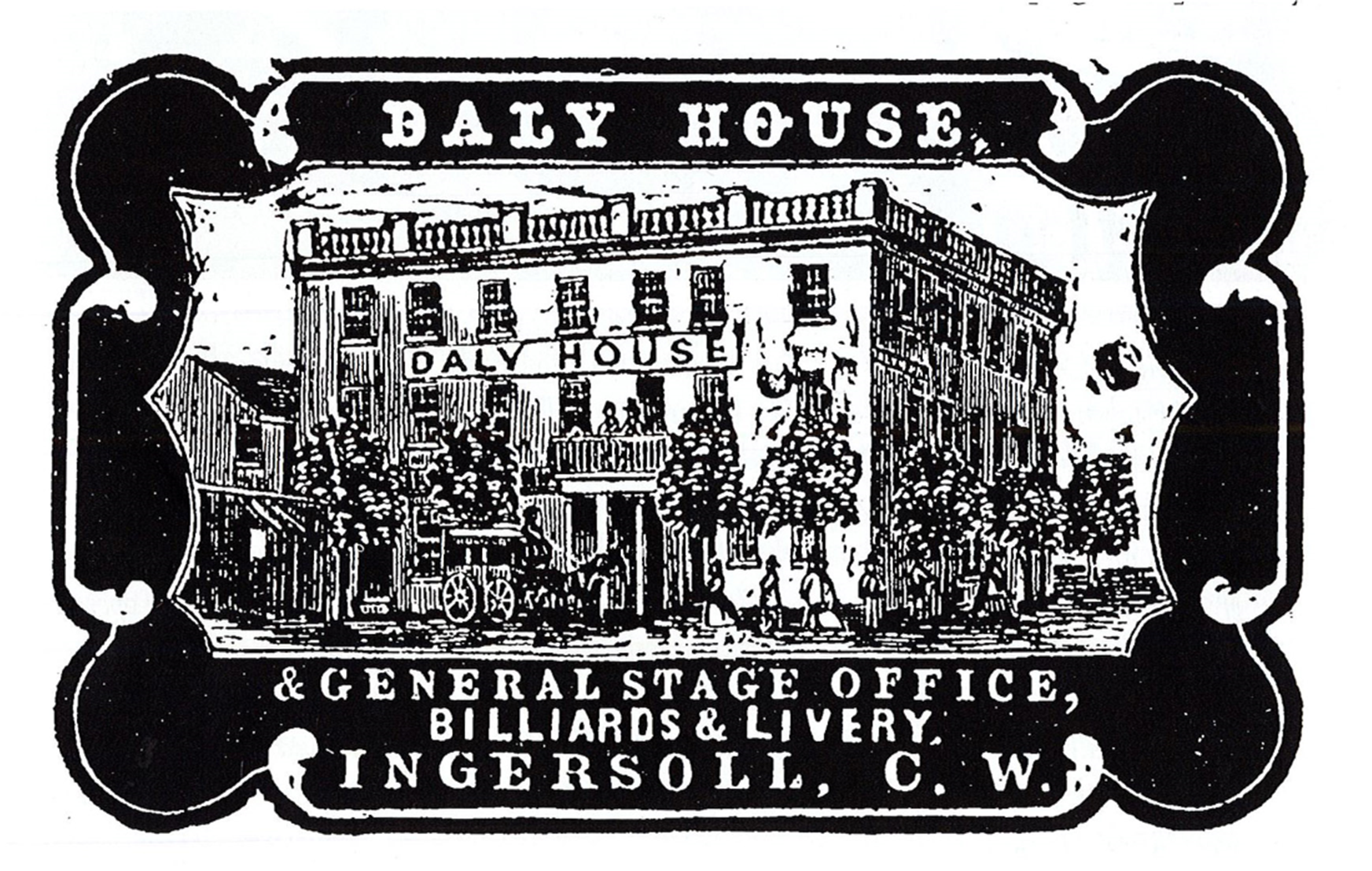

The Ingersoll Inn, formerly the Daly House, in Ingersoll c. 1920.
Ingersoll was a prime destination for formerly enslaved peoples because of employment possibilities. There was still much land to be cleared in the area as timber was in great demand for constructing buildings, roads and the Great Western Railway. The Ingersoll Wesleyan Methodist Church, built in 1854, became a source of refuge on the arrival in Ingersoll of the formerly enslaved. The church had a second story where the minister lived and the basement was used as a hiding place until other accommodations could be arranged. This church was located in the area of 110 Oxford Street.
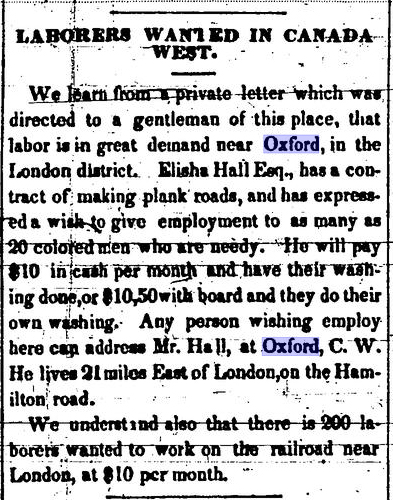
The Voice of The Fugitive, 7 May 1851

Oxford Street Wesleyan Methodist Church, c. 1950
By 1855, the Harvey Jackson family had moved to Chatham, Ontario. As a member of the Provincial Union Association, he supported black self-help and opposed begging. Jackson organized and served as secretary of the Dawn Investigating Committee meeting at Chatham in August 1855. Apparently well educated, he advocated education and professional training for blacks, worked with William Howard Day and Harriet Tubman to aid fugitive slaves arriving in the province, and probably collaborated with John Brown during 1858, when the abolitionist was in Chatham to organize the Harpers Ferry raid. Shortly after Brown’s death, Jackson penned a “Response of the Colored People of Canada,” in which he defended Brown’s objectives and appealed for funds for the families of the “Harpers Ferry Martyrs”. Harvey C. Jackson had played an important role in noted abolitionist John Brown’s Canadian campaign recruiting and soliciting funds and had accompanied Brown on many of his routes across the area.

Resolution by a meeting of Chatham Blacks – Published in the Provincial Freeman June 30 1855 (The meeting was held 23, June 1855 at the First Baptist Church, Chatham, Canada West)
Broadside published by Harvey C. Jackson to raise money to help the families of those killed at Harper’s Ferry (source: “A Safe Haven: the story of the Black Settlers of Oxford County” by Joyce A. Pettigrew):
AN ADDRESS TO THE COLORED PEOPLE OF CANADA
“Fellow citizens: - You are all aware of the excitement recently created at Harpers Ferry, in the State of Virginia. In consequence of the bold and heroic attack upon slavery, made by Capt. John Brown and a few others, whose object was to break the chains of that accursed institution. You are also aware that their attempt was a failure, so far as the immediate emancipation of our kindred were concerned. But that bold attempt to liberate the slaves will be attended with the most important results. It has already enlightened public opinion more than all the anti-slavery speeches of the last ten years: it has caused anti-slavery newspapers and letters to penetrate the very centre of those despot states...........
Some persons may brand Brown’s effort as Brash, futile and wild, but they must acknowledge that it will be productive of much good, or renounce their judgement. Christianity never spread so fast at any other period than it did when the earth was made gory by the blood of martyrs. Brown and his confederates are martyrs to the cause of Liberty, and their blood will cry out from the earth and gain many advocates to Freedom. But, even supposing that the contrary was the case; the intent, the aim was good, in behalf of our oppressed race, and we should do our duty, - show the world that we appreciate such noble and philanthropic actions. By the martyrdom of Capt. Brown, and his noble confederates, a parcel of widows and orphans sharing the same sympathy toward our race, are left without means to meet the necessities of life, and it is for you to say whether you will assist in providing for the widows and in educating the orphans? I know you will assist. Coming ages will appreciate Capt. Brown’s worth, his greatness of soul.
Let there be a meeting called in every locality where colored persons resides. Let the “whites” be solicited to aid in the glorious and heavenly enterprise; let each locality remit what is collected to Mr. Samuel Sewel, 46 Wellington Street, Boston.................................”
Yours forthe cause of humanity.
Harvey C. Jackson, Simcoe, C.W., Dec.7, 1859.
According to the 1871 census, the Harvey Jackson family was living north of London, in London Township and he was working a gardener. Sarah & Harvey had 8 children, Calisthenese, Ida, Aristarchus, Harvey, Ophelia, Senta, Llewellyn & Lydia. By 1881, the family had moved back to the United States and Harvey was a minister in Canton, Ohio. Harvey Jackson died in 1897 and rests at West Lawn Cemetery, Canton, Stark County, Ohio, USA.
Woodstock’s Hawkins Chapel
The story of a chapel that brought a community together on Park Row in Woodstock, Ontario.
By Megan Lockhart, Archives Technician
The former church known as Hawkins Chapel on Park Row in Woodstock, Ontario, was established by two men who had escaped slavery in America; George Washington, a porter at the O’Neill House, and Dan Anderson, a stonemason. The church was also commonly known as the Park Row Community Chapel by locals. Washington and Anderson began their work to establish a British Methodist Episcopal Church for Woodstock's Black community in 1883. They canvassed door to door at local houses to garner support for the construction of a chapel and, by 1886, the two men purchased a lot at 257 Park Row.
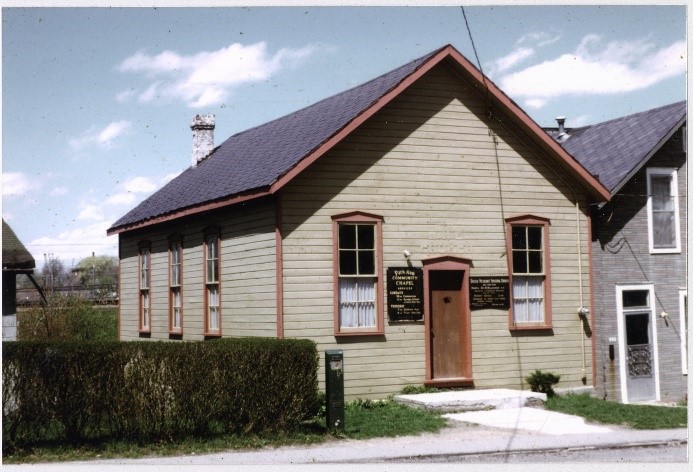
The Park Row Community Chapel in Woodstock, Ontario. This photo was taken pre-1970s, when the chapel was still in use for religious services.
The wood frame chapel, which had a 200 seat capacity, was finally opened on December 2, 1888 and would eventually provide service to around 75 local Black families. The church eventually became known by the name of its first minister Right Rev. Walter Hawkins. Over the years, local white families also began attending the church, as one minister Rev. Winston H.H. Clarke stated: “There are no colour lines in our church; we deal with the character of the people.”
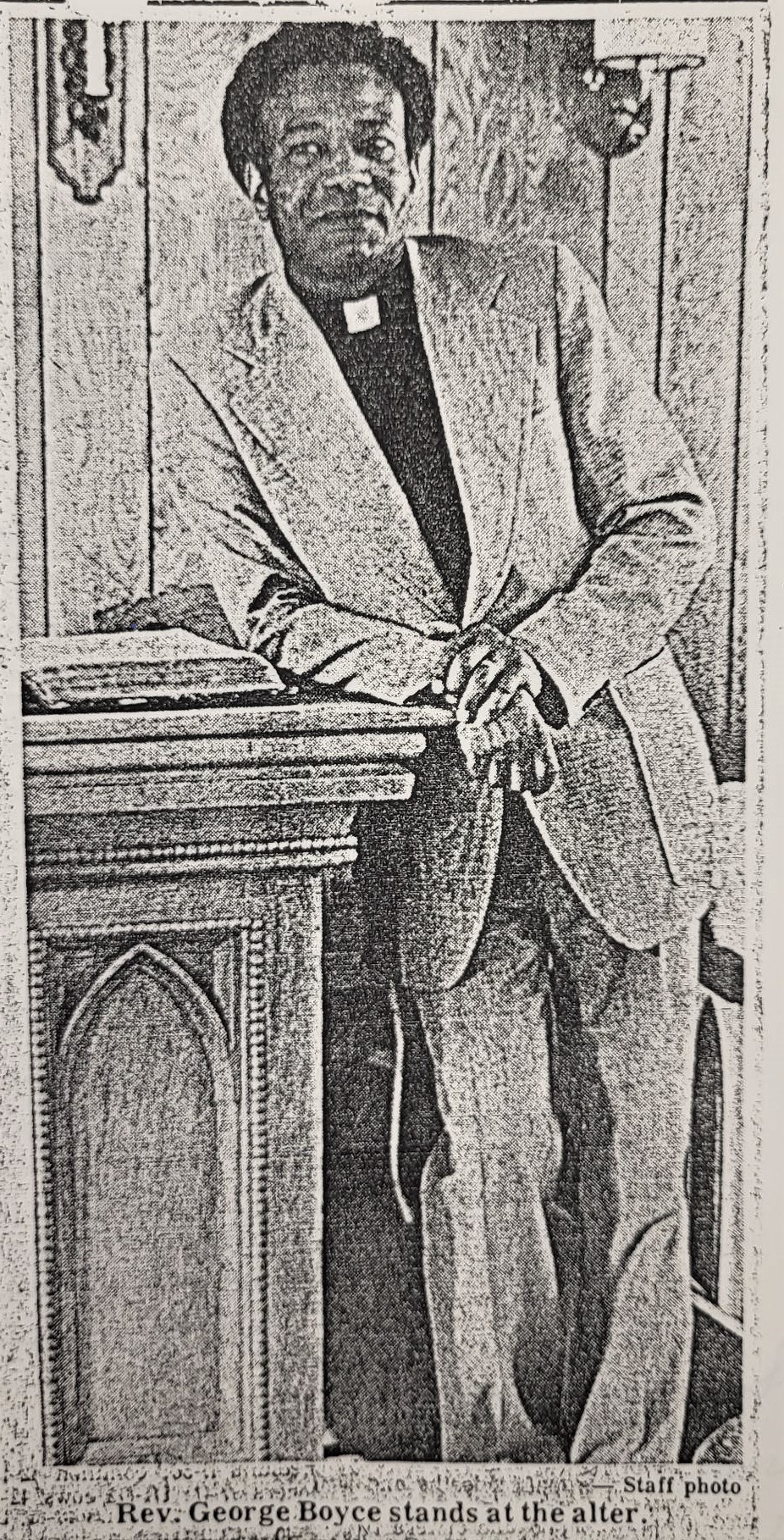
Reverend George Boyce standing at the altar in the Park Row Community Chapel (also known as Hawkins Chapel), ca. 1977.
The church closed in 1972 for several years. In July, 1977, Rev. George Boyce re-opened the church and painted it black and white, as evidence that it was open to any race. Despite the almost decade-long revival, the church was closed permanently in 1986. Since then, the building has been converted to be used as a private home.
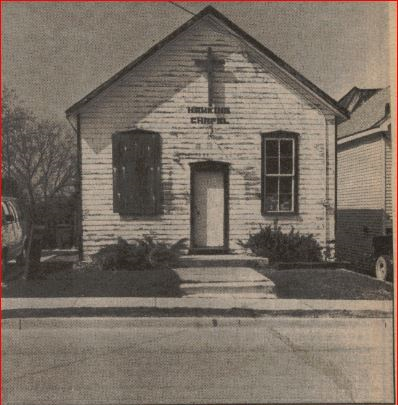
The Hawkins Chapel, sitting empty after its closure in 1986.
The Wesleyan Methodist Church: Ingersoll’s Haven for People Escaping Slavery
By Megan Lockhart, Archives Technician
In celebration of Black History Month, our blog articles this month will be focused on the history of the Black community in Oxford County. Today I'm delving into the history of a local church that was a significant site related to the Underground Railroad.
The Wesleyan Methodist Church was built on the west side of Oxford Street (now 110 Oxford St.) in Ingersoll, Ontario in 1854. It was physically constructed through volunteer labour, Ingersoll residents who had been formerly enslaved before fleeing to Canada volunteered their skills and time to help build the church. Many local Black residents had valuable construction skills, such as bricklaying and roofing. The church had a capacity for around 500 people; the minister's living quarters were located on the top floor. The church was most notably a safe haven for people escaping slavery. Assisted by Quakers who held strong anti-slavery beliefs, Black people were fleeing to Southwestern Ontario from plantations in the American South, even from as far as New Orleans, Louisiana. Having to work under the protection of darkness, people escaping slavery were secretly smuggled into the attic of the Wesleyan Methodist Church at night. The church was a well-known terminal of the Underground Railroad. Some people arrived in Ingersoll by stagecoach from Port Burwell, Ontario; an operation run by abolitionist Harvey C. Jackson. Ingersoll locals who condemned slavery provided employment opportunities for freed people on nearby farms.
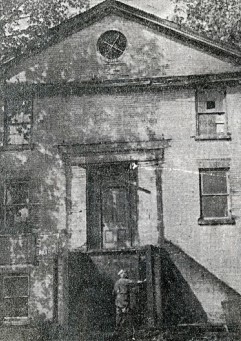
The former Wesleyan Methodist Church in Ingersoll, Ontario. The photo was taken by Stanley J Smith in 1956. Courtesy of the Ingersoll Public Library.
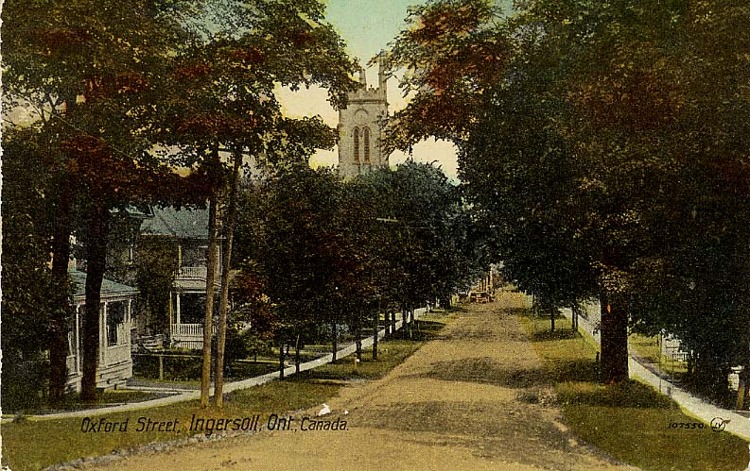
A view of Oxford Street in Ingersoll, Ontario, circa the early 1900s. [J. Gruszka PC 0171]
A number of famous individuals spoke at the church, including abolitionist John Brown in 1858. Amelia Webster was also a famous speaker at the church. Webster had spent months in an American prison in the South, charged with teaching enslaved people how to read and write. The church choir included many local Black residents.
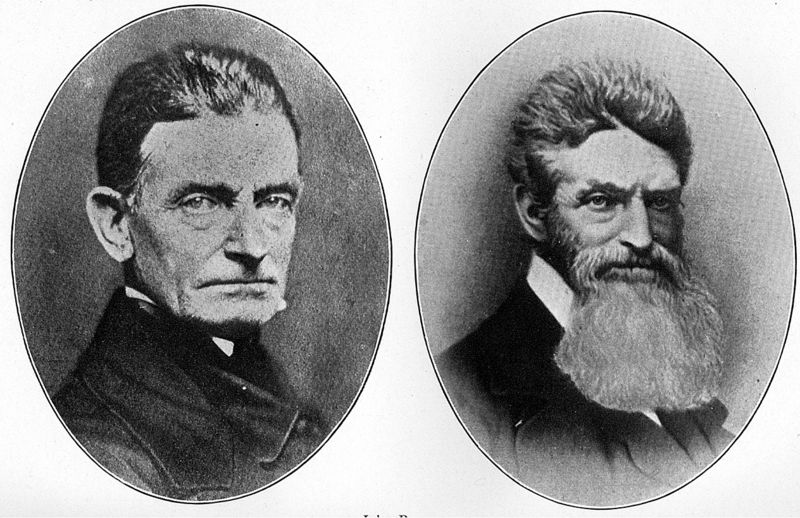
Portraits of American abolitionist John Brown. Courtesy of Wikimedia Commons.
The church no longer provided religious services after 1865, when the Wesleyans moved to another location on King Street. The building was, however, the first public building in Ingersoll to be lit by electricity. After its closure as a church, the building housed a number of local businesses. Today, the building is no longer standing.
International Singer, Painter, and “Best Hatted” Woman: Mary Bothwell
By Liz Dommasch, Archivist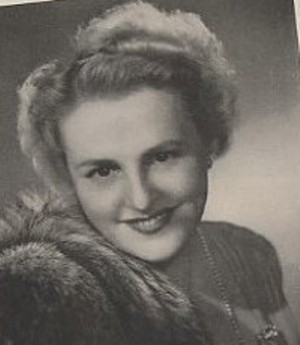
Born on November 5, 1898, in Hickson, Ontario, Mary Janette Bothwell was the daughter of William A. Bothwell and his wife Ellen Clark. Growing up, she attended Hickson Public School and gained an early love of music from her father who was an amateur violinist. In fact, she is noted to have vowed that she could carry a tune before she could walk! As a young girl, she studied art in Toronto, then entered the Toronto Academy of Music where she studied singing with the famous tenor and teacher Otto Morando, and piano with Peter C. Kennedy. From 1920-1929 she sang as a contralto in opera and oratorio in Toronto and Buffalo. In 1937, she undertook further studies at the Mozarteum in Salzburg, where she made her European debut, and a year later made her New York debut on November 1st at Town Hall where she continued to appear until the 1960s.
In 1947, she made her first European tour which included performances in Germany, the Netherlands, and England, where she drew praise from even the German critics. Notable successes included her performance at the Scheveningen Festival in Holland and her Promenade concerts at London’s Albert Hall singing under the famous conductor, Sir Adrian Boult. A year later she would perform under Sr. Boult again, this time with the BBC SO, and again the following year at Toronto’s Varsity Arena.
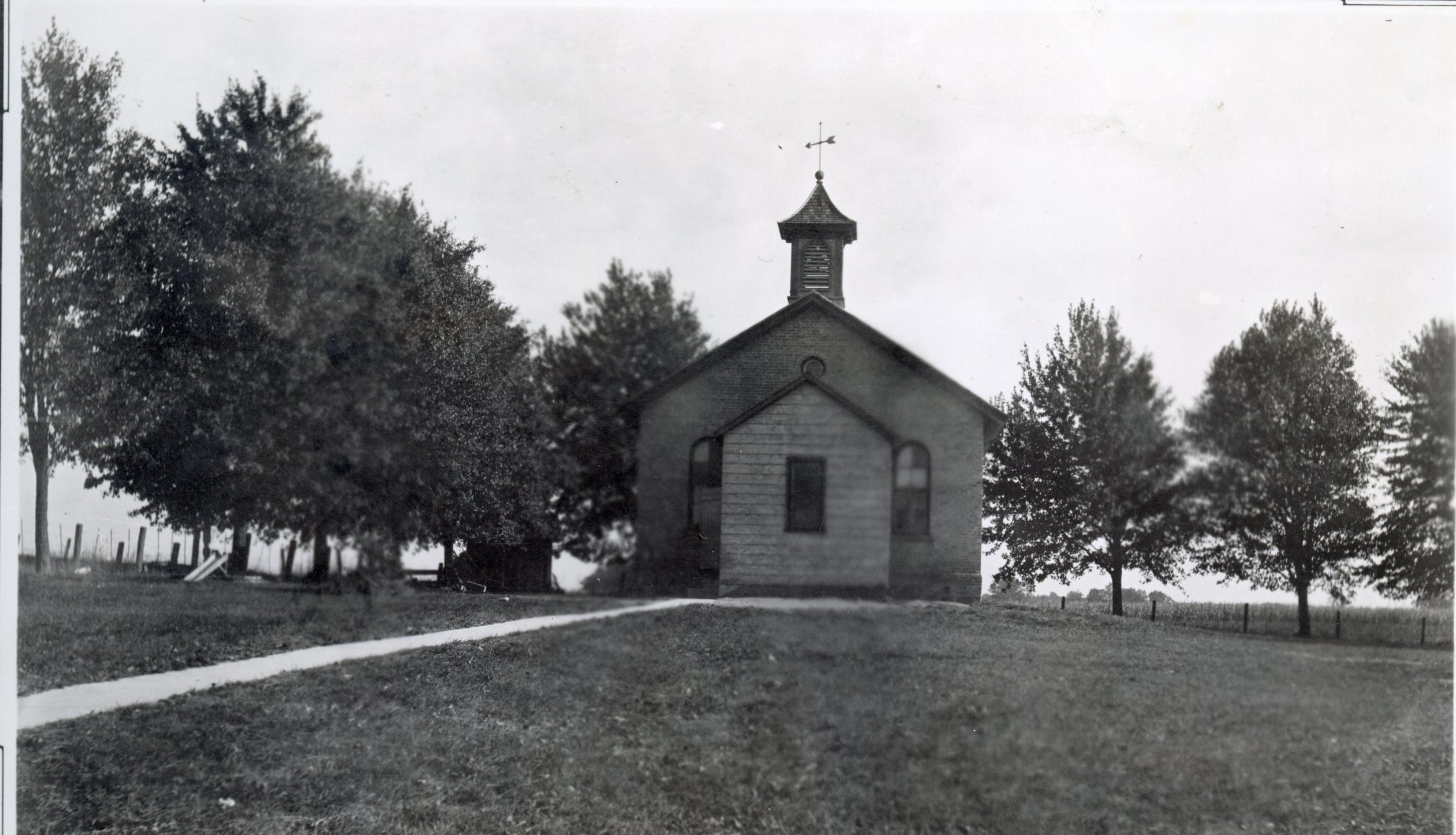
The public school in Hickson where Mary Bothwell attended during her childhood.
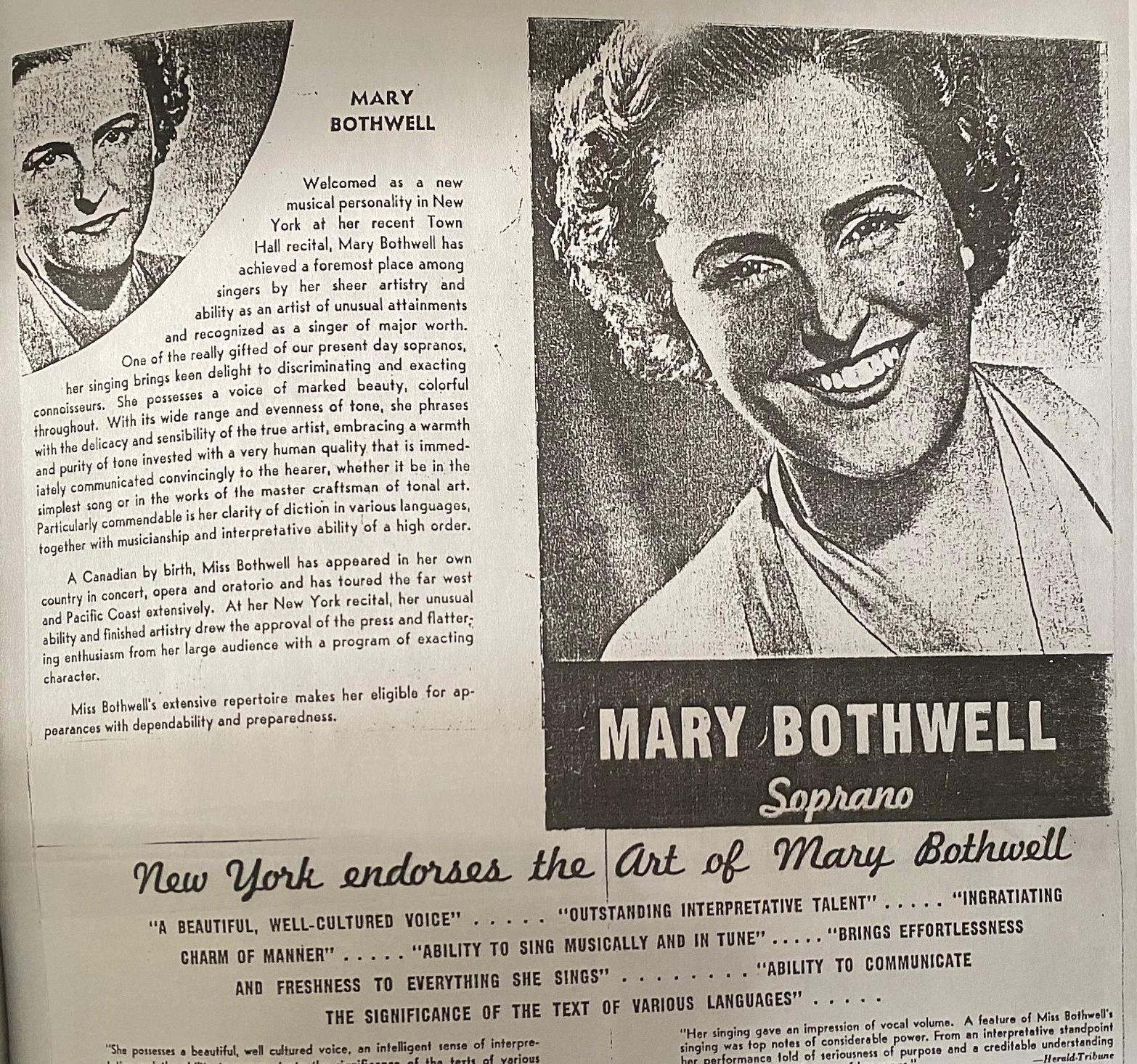
An advertisement for musical artist Mary Bothwell. Click the photo to enlarge it.
In addition, over the years she performed on radio in New York, Paris, London, and Basel and would gain an international reputation in concert and opera singing. During that time, she made several tours of Canada and the United States, and during WWII she entertained Canadian troops in the Netherlands.
In 1958, she was elected president of the Canadian Women's Club of New York City and, during her term as president, encouraged the careers of young Canadian performers. As president, she not only oversaw lectures, musicals, and cocktail parties but would raise more than $400 for a scholarship fund to help defray the expenses of a female Canadian singer studying in New York. She was also an amateur candlemaker and painter; she became known in the art world for her paintings of flowers. "Wild Flowers of Switzerland", 36 botanical studies in oil by Mary Bothwell, was exhibited for the first time at the Horticultural Society of New York on April 18, 1971.
A collector of hats, for seven consecutive years she was voted one of the “Best hatted women in America” and was even elected to the hat wearers' “Hall of Fame”.
As a hobby, she collected toy elephants, of which many were presented to her in various parts of the world. Her collection of well over 1,000 toys is said to include elephants that could talk, sing, dance, and walk, and were fashioned from everything from felt, ivory, gold, and diamonds to even twine.
Mary Bothwell passed away on May 3, 1985, in New York City at the age of 89 years. Her cremated remains were buried in the Presbyterian Cemetery in Woodstock, Ontario.
Image credits:
Mary Bothwell: https://commons.wikimedia.org/wiki/File:BothwellMary.jpg
Advertisement re. Mary Bothwell: COA114 Hickson Women’s Institute fonds, Tweedsmuir History Book No. 4.
Hickson Public School: COA114 Hickson Women’s Institute fonds, Tweedsmuir History Book 2, Vol. 2.
Page:
of
25